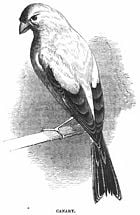Difference between revisions of "Canary" - New World Encyclopedia
(→References: minor) |
|||
| Line 38: | Line 38: | ||
==References== | ==References== | ||
| − | *Clement, Harris and Davis | + | *Clement, Peter, illustrated by Harris, Alan and Davis, John, ''Finches & sparrows : an identification guide.'' Princeton, N.J. : Princeton University Press, 1993. ISBN 0691034249. |
| − | *Hagemeijer, | + | *Hagemeijer, Ward J. M., & Blair, Michael J., ''The EBCC atlas of European breeding birds : their distribution and abundance.'' London : T & A D Poyser, 1997. ISBN 0856610917. |
| − | *Snow, D. W. & Perrins, C. M. '' | + | *Snow, D. W. & Perrins, C. M., ''The Birds of the Western Palearctic.'' Oxford ; New York : Oxford University Press, 1998. ISBN 019854099X. |
==External links== | ==External links== | ||
Revision as of 02:33, 22 October 2007
| Canary | ||||||||||||||
|---|---|---|---|---|---|---|---|---|---|---|---|---|---|---|
 | ||||||||||||||
| Scientific classification | ||||||||||||||
| ||||||||||||||
| Serinus canaria (Linnaeus, 1758) |
The Canary (Serinus canaria) sometimes called the Island Canary, Wild Canary or Atlantic Canary, is a small bird in the finch family.
This bird is native to the Azores, the Canary Islands, and Madeira. The bird was named after the Canary Islands, not the other way around. In turn, the color canary yellow is named for the yellow canary.
It is 12.5-13.5 cm long, with a wingspan of 20-23 cm and a weight of 15-20 g. It is yellow-green, with brownish streaking on its back. It is about 10% larger, longer and less contrasted than its relative the Serin, and has more grey and brown in its plumage and relatively shorter wings. The song is a silvery twittering like the Goldfinch.
Its habitat is semi-open areas such as orchards and copses, where it nests in bushes or trees, from sea level up to 1,500 m altitude.
The population is considered stable, with the following totals:
- Azores: 30,000-60,000 pairs.
- Canary Islands: 80,000-90,000 pairs.
- Madeira: 4,000-5,000 pairs.
Captivity
This species is often kept as a pet; see Domestic Canary for details.
Notes
- BirdLife International 2004. [1]. 2006 IUCN Red List of Threatened Species., World Conservation Union. Retrieved on 12 May 2006. Database entry includes justification for why this species is of least concern.
ReferencesISBN links support NWE through referral fees
- Clement, Peter, illustrated by Harris, Alan and Davis, John, Finches & sparrows : an identification guide. Princeton, N.J. : Princeton University Press, 1993. ISBN 0691034249.
- Hagemeijer, Ward J. M., & Blair, Michael J., The EBCC atlas of European breeding birds : their distribution and abundance. London : T & A D Poyser, 1997. ISBN 0856610917.
- Snow, D. W. & Perrins, C. M., The Birds of the Western Palearctic. Oxford ; New York : Oxford University Press, 1998. ISBN 019854099X.
External links
- Madeira birds - Canary, Madeira Birds. Retrieved September 29, 2007.
- Canary videos, The Internet Bird Collection (IBC). Retrieved September 29, 2007.
Credits
New World Encyclopedia writers and editors rewrote and completed the Wikipedia article in accordance with New World Encyclopedia standards. This article abides by terms of the Creative Commons CC-by-sa 3.0 License (CC-by-sa), which may be used and disseminated with proper attribution. Credit is due under the terms of this license that can reference both the New World Encyclopedia contributors and the selfless volunteer contributors of the Wikimedia Foundation. To cite this article click here for a list of acceptable citing formats.The history of earlier contributions by wikipedians is accessible to researchers here:
The history of this article since it was imported to New World Encyclopedia:
Note: Some restrictions may apply to use of individual images which are separately licensed.
